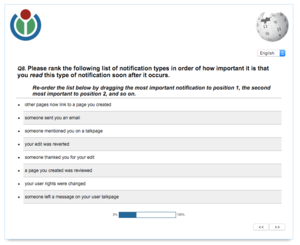DS4UX (Spring 2016)/Wikipedia Notifications survey: Difference between revisions
No edit summary |
No edit summary |
||
| (3 intermediate revisions by the same user not shown) | |||
| Line 1: | Line 1: | ||
== | [[File:Notifications_survey_prioritization.png|thumb|A screenshot of the survey.]] | ||
[[File:Notifications-Flyout-Screenshot-07-31-2013.png|thumb|A screenshot of the Notifications feature.]] | |||
The Wikimedia Foundation is working on updates to [https://www.mediawiki.org/wiki/Notifications the Notifications feature of MediaWiki], a panel that alerts editors to important, relavant events that have occured since they last logged in. | |||
;Types of notifications: There are currently 8 types of notification that a user can receive | |||
* someone @mentioned you in a discussion | |||
* someone left you a message on your user page | |||
* someone reverted one of your edits | |||
* someone changed your userrights | |||
* someone sent you an email | |||
* someone thanked you for your edit | |||
* someone reviewed an article you created | |||
* someone linked to an article you created | |||
In order to understand how to prioritize their work, the product team at Wikimedia that is in charge of the Notifications feature needs to know how editors currently use the feature: what they value, what annoys them, what confuses them, etc. | |||
We released a survey targeted at these editors, and asked them a variety of questions about how their usage of Notifications, and how we could improve the feature to make it better meet their needs. In that survey, we asked respondents to identify notifications that they have seen before, and then asked them to rank these notifications in order of how important/informative they were. | |||
The ZIP file linked below contains a file called <code>notifications_ranking_survey_data.csv</code> contains anonymized responses from over 100 users, as well as some heavily-commented scripts for processing that file and outputting aggregated statistics from those responses. In class, we'll walk through this step by step, to show the process involved in transforming raw data in research findings! | |||
== Code and data == | |||
<font size="+1">[http://jtmorgan.net/ds4ux/week4/notifications.zip Click here to download the Notifications data and scripts]</font> | <font size="+1">[http://jtmorgan.net/ds4ux/week4/notifications.zip Click here to download the Notifications data and scripts]</font> | ||
== Analysis == | == Analysis == | ||
* How many people report having seen each type of notification? | To see how these questions are answered, ead the multi-line comments (the ones surrounded by """) and un-comment print statements 1-by-1 in the files below as you walk through the code. | ||
* Which types of notifications are | |||
* ''How do import this dataset into Python? How should we structure the data we import?'' — run <code>notifications.py</code>. | |||
* ''How many people report having seen each type of notification?'' — run <code>count_notifications.py</code>. | |||
* ''Which types of notifications are ranked #1 priority by the most people?'' run <code>rank_notifications1.py</code>. | |||
* ''Which types of notifications are ranked among the top THREE highest priority by the most people?'' run <code>rank_notifications2.py</code>. | |||
Latest revision as of 03:18, 18 April 2016


The Wikimedia Foundation is working on updates to the Notifications feature of MediaWiki, a panel that alerts editors to important, relavant events that have occured since they last logged in.
- Types of notifications
- There are currently 8 types of notification that a user can receive
- someone @mentioned you in a discussion
- someone left you a message on your user page
- someone reverted one of your edits
- someone changed your userrights
- someone sent you an email
- someone thanked you for your edit
- someone reviewed an article you created
- someone linked to an article you created
In order to understand how to prioritize their work, the product team at Wikimedia that is in charge of the Notifications feature needs to know how editors currently use the feature: what they value, what annoys them, what confuses them, etc.
We released a survey targeted at these editors, and asked them a variety of questions about how their usage of Notifications, and how we could improve the feature to make it better meet their needs. In that survey, we asked respondents to identify notifications that they have seen before, and then asked them to rank these notifications in order of how important/informative they were.
The ZIP file linked below contains a file called notifications_ranking_survey_data.csv contains anonymized responses from over 100 users, as well as some heavily-commented scripts for processing that file and outputting aggregated statistics from those responses. In class, we'll walk through this step by step, to show the process involved in transforming raw data in research findings!
Code and data[edit]
Click here to download the Notifications data and scripts
Analysis[edit]
To see how these questions are answered, ead the multi-line comments (the ones surrounded by """) and un-comment print statements 1-by-1 in the files below as you walk through the code.
- How do import this dataset into Python? How should we structure the data we import? — run
notifications.py. - How many people report having seen each type of notification? — run
count_notifications.py. - Which types of notifications are ranked #1 priority by the most people? run
rank_notifications1.py. - Which types of notifications are ranked among the top THREE highest priority by the most people? run
rank_notifications2.py.
